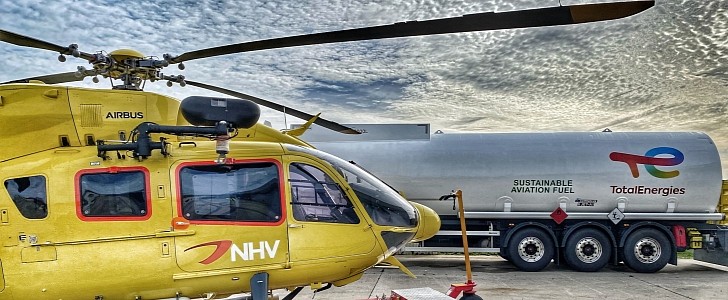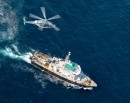Not just commercial jets, but also helicopters are paving the way for future green operations, powered by sustainable aviation fuel (SAF). Several helicopter flights operated by this “magical” fuel have already been conducted by various operators throughout last year. This time, it’s about a new milestone – for the first time ever, SAF was used for a helicopter flight in the offshore wind industry.
This pioneering project involved three main players – Elia, NHV, and TotalEnergies. The first one is Belgium’s Electricity System operator, and was the one who initiated the event. TotalEnergies is a familiar name to those interested in SAF, because it’s one of the biggest European producers of sustainable fuel.
Based in Ostend, Belgium, NHV is an operator specializing in B-to-B helicopter services. This includes offshore operations, and its fleet boasts four types of helicopters for this particular sector. The largest one is the Airbus H175, with a 16-passenger capacity and a maximum speed of 150 knots (172 mph/277 kph).
The flight took place earlier this month, when an NHV helicopter took off from the company’s headquarters, and flew to a platform in the North Sea, where cables from offshore wind farms are gathered and connected to the mainland. In addition to Elia representatives, Belgian politicians also got to experience this unique flight.
The particular SAF used to power the NHV helicopter is made in two main steps. First, waste and residues such as used cooking oil are turned into a “renewable fraction,” which is then blended with up to 30% conventional fuel (JET A-1).
This blend allows aircraft to use it as a drop-in fuel, without any modifications to the engine or the infrastructure. The goal in the aviation industry is to eventually certify the use of unblended, 100% SAF, and each of these successes is one step further down that road.
NHV says that the SAF-powered flight resulted in a 27% reduction in CO2 emissions.
If they plan to survive next to eVTOLs (electric vertical takeoff and landing) helicopters must also become greener, and SAF is seen as the fastest and most practical solution for now.
Based in Ostend, Belgium, NHV is an operator specializing in B-to-B helicopter services. This includes offshore operations, and its fleet boasts four types of helicopters for this particular sector. The largest one is the Airbus H175, with a 16-passenger capacity and a maximum speed of 150 knots (172 mph/277 kph).
The flight took place earlier this month, when an NHV helicopter took off from the company’s headquarters, and flew to a platform in the North Sea, where cables from offshore wind farms are gathered and connected to the mainland. In addition to Elia representatives, Belgian politicians also got to experience this unique flight.
The particular SAF used to power the NHV helicopter is made in two main steps. First, waste and residues such as used cooking oil are turned into a “renewable fraction,” which is then blended with up to 30% conventional fuel (JET A-1).
This blend allows aircraft to use it as a drop-in fuel, without any modifications to the engine or the infrastructure. The goal in the aviation industry is to eventually certify the use of unblended, 100% SAF, and each of these successes is one step further down that road.
NHV says that the SAF-powered flight resulted in a 27% reduction in CO2 emissions.
If they plan to survive next to eVTOLs (electric vertical takeoff and landing) helicopters must also become greener, and SAF is seen as the fastest and most practical solution for now.








